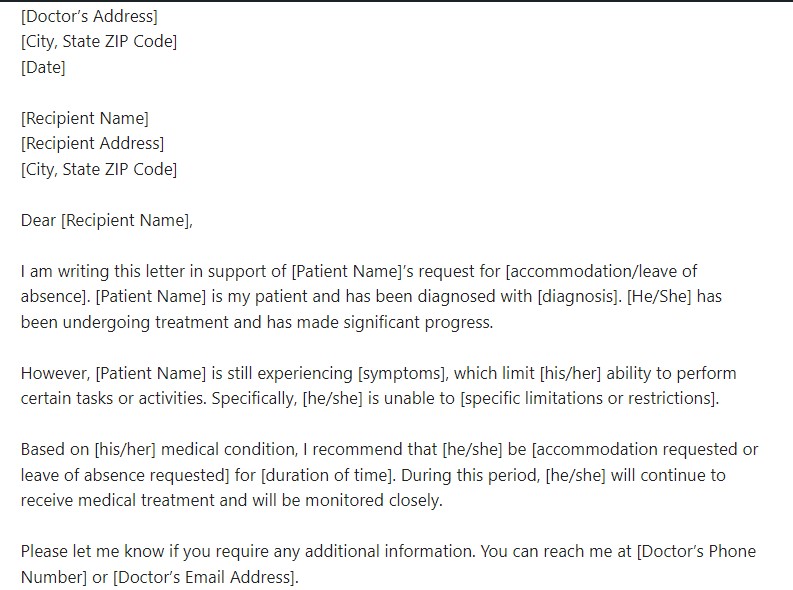A doctor’s letter is a formal document written by a healthcare provider to provide medical information or to support a patient’s request for an accommodation or leave of absence.
Here are some frequently asked questions (FAQs) regarding doctor’s letters:
Q: What is a doctor’s letter?
A: A doctor’s letter is a formal document written by a healthcare provider to provide medical information or to support a patient’s request for an accommodation or leave of absence.
Q: When should a doctor’s letter be used?
A: A doctor’s letter should be used when a patient needs to provide medical information or support for a request for an accommodation or leave of absence, such as for a medical condition, disability, or injury.
Q: What should be included in a doctor’s letter?
A: A doctor’s letter should include the patient’s name, date of birth, diagnosis, treatment plan, prognosis, and any limitations or restrictions that the patient may have. It should also state the healthcare provider’s contact information and signature.
Q: Is a doctor’s letter required by law?
A: A doctor’s letter is not always required by law, but it can be helpful in providing evidence to support a request for an accommodation or leave of absence under the Americans with Disabilities Act (ADA) or other laws.
Q: Can a doctor’s letter be challenged?
A: A doctor’s letter can be challenged if the information provided is not accurate or if the healthcare provider is not licensed or qualified to provide medical advice. It is important to seek medical advice from a qualified healthcare provider.
Q: Can a doctor’s letter be used for travel or insurance purposes?
A: A doctor’s letter can be used for travel or insurance purposes if it provides the necessary medical information and is accepted by the relevant authorities or insurance provider. It is important to check with the specific requirements of the travel or insurance provider.
Here are some tips on how to write a doctor’s letter:
1. Use a professional tone: Use professional language and tone throughout the letter, and make sure to address the recipient appropriately.
2. Provide relevant medical information: Provide relevant medical information, such as the diagnosis, treatment plan, and prognosis, as well as any limitations or restrictions that the patient may have.
3. Be specific: Be specific about the patient’s condition and how it affects their ability to perform certain tasks or activities.
4. Be concise: Keep the letter concise and to the point, and avoid unnecessary details or information.
5. Include contact information: Provide contact information for the healthcare provider, including their name, title, and phone number or email address.
Here is a sample doctor’s letter:
[Doctor’s Name]
[Doctor’s Address]
[City, State ZIP Code]
[Date]
[Recipient Name]
[Recipient Address]
[City, State ZIP Code]
Dear [Recipient Name],
I am writing this letter in support of [Patient Name]’s request for [accommodation/leave of absence]. [Patient Name] is my patient and has been diagnosed with [diagnosis]. [He/She] has been undergoing treatment and has made significant progress.
However, [Patient Name] is still experiencing [symptoms], which limit [his/her] ability to perform certain tasks or activities. Specifically, [he/she] is unable to [specific limitations or restrictions].
Based on [his/her] medical condition, I recommend that [he/she] be [accommodation requested or leave of absence requested] for [duration of time]. During this period, [he/she] will continue to receive medical treatment and will be monitored closely.
Please let me know if you require any additional information. You can reach me at [Doctor’s Phone Number] or [Doctor’s Email Address].
Sincerely,
[Doctor’s Name]
